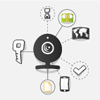8 Tech Hobbies That Are Older Than You Think

:: By Diana Zelikman, Fueled
It might seem like new technology is cropping up faster than ever, but some popular tech hobbies might be older than you think. You might find yourself surprised at some of the ones we compiled below.
Blogging
Justin Hall is credited as having the first blog back in 1994 when he was a student. Throughout the 1990s, forums and corkboard style communication were common and are still used throughout, the most well-known being reddit. Some earlier forms of blogging, ones that were more like a diary than what we think of blogging today, included LiveJournal and Xanga. People have been recording their daily lives and goings on in the world since the Renaissance when the individual was beginning to gain importance, so it should come as no surprise that the Internet has just become the new medium of diary keeping in this day and age.
Computer Programming
The abacus, created in 2500 BC, was the first example of a mechanical device used for numerical computation. While historically technology grew at a very slow pace, only in the last 50 years have we made miraculous jumps in the field. FORTRAN (Formula Translation), the world's first high level programming language, was invented in 1954 and used punch cards. Eventually, punch cards were phased out as processing power began to increase so did the sophistication of the languages used. Now many high level programming languages exist, including Perl, Ruby, and PHP.
Channel surfing
Having multiple browsers open with a dozen tabs each, flicking from channel to channel on the TV - whatever it is we're doing with tech, it seems we can't do just one thing. Channel surfing as a phenomenon that was first mentioned in the 1990s - Phillip Swann wrote, 'Few viewers today can sit through an entire program without picking up the remote and checking out another channel . . . Today's viewer needs constant gratification: If she's not entertained or intrigued for any stretch of time, she will flip the dial." We have so many more channels now too - and can record them at will.
Photo Sharing
Instagram was launched in Oct. 2010, acquired by Facebook years later, and now features integrated advertising. It wasn't the first photo sharing service, though. Photo sharing began in the 1990s on sites where you could order prints. In the 2000s, sites like WebShots, Flickr, and DeviantArt started gaining prominence and have many copycats. Tumblr and Imgur have exploded in recent years.
Designing Apps
Even if you've never designed one, you've probably dreamed up a few of the 'most useful apps ever.' We're so used to thinking of apps as mobile apps though that we forget their origins. In fact, all software on your computer which serves you, rather than software that serves other software which then serves you, is an application - so that's Paint, Notepad, and even Word.
Online gaming
The term massively multiplayer online role-playing game (MMORPG) was first coined way back in 1997 and role-playing games on university mainframe MUD computers started way back in the 1970s. World of Warcraft is one of the most successful MMORPGs in the world, with 7.8 million subscribers as of December 2013.
Bitcoin Investing
Bitcoin was the first cryptocurrency and it began trading back in 2009. While many people have only started hearing about it in recent years, it's been gaining popularity and notoriety for the past five even though it's still in beta testing. It's biggest controversy is being able to sell and purchase items on the black market anonymously.
Social Media Lurking
Social media stalking has its obvious pre-Internet origins, but what about social media lurking? You're there but you don't want anyone to know it so you don't really 'like' or comment or share, you just nose around and get annoyed that the Internet is boring while not actually contributing to it yourself. Facebook's recent 10 year anniversary reminds us how long we've been doing this. Some online social communities were available in APRANET, LISTSERV, and USENET in the 1970s but generally fostered more active engagement. The new generation of social networking sites started with SixDegrees in 1997, then Friendster came in 2002. As soon as the social networks were there, we started spending time on them - and pretending that we weren't. Some of us will always play the wallflower.
Diana Zelikman is an editor at Fueled, the leading iPhone app builder in New York City, renowned for its award winning mobile design and strategy.

Subscribe to Our Newsletter!
Latest in Marketing








